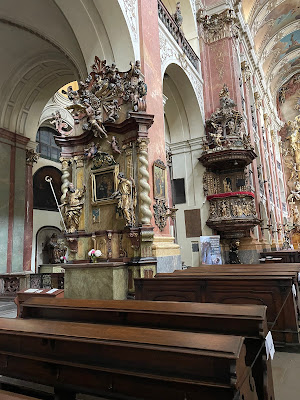Prague - We took a private hire car (using Bolt app) and it was quick, fast and reliable. For my family it was cheaper to get into Old Town than taking the public transport.
Jan Hus Monument
An Art Nouveau-style monument that pays tribute to reformer Jan Hus, who was burned alive in 1415, after being denounced as a heretic. This led to the Hussite Wars.
The huge monument depicts victorious Hussite (were a Czech proto-Protestant Christian movement that followed the teachings of reformer Jan Hus) warriors and Protestants who were forced into exile 200 years after Hus in the wake of the lost Battle of the White Mountain during the Thirty Years' War, and a young mother who symbolises national rebirth.
The Astronomical Clock
When wandering through the enchanting streets of Prague, one cannot miss the grand spectacle that is the Astronomical Clock, prominently situated on the southern wall of the Old Town Hall in Old Town Square. This intricate timepiece, dating back to the early 15th century, is not just a clock but a magnificent fusion of art, science, and history, captivating tourists and locals alike. Crowds of tourist gather below this clock every hour.
Paxton was enthusiastically explaining this marvellous work of medieval engineering.
Constructed in 1410 by clockmaker Mikuláš of Kadaň and astronomer Jan Šindel, the Astronomical Clock is one of the oldest working astronomical clocks in the world. Unlike conventional clocks, it does far more than merely tell the time. The clock is composed of three main components:
1. The Astronomical Dial: This dial is the heart of the clock, showcasing a map of the sky with the Earth at its center. It indicates the positions of the sun and the moon in the sky, the zodiacal ring, and various astronomical details. This dial alone offers a wealth of information, from the time of day to the movement of celestial bodies.
2. The Walk of the Apostles: Every hour, on the hour, the clock springs to life with the procession of the Twelve Apostles. This captivating spectacle attracts crowds who gather to watch as the figures of the apostles pass by the windows above the clock, blessing onlookers with their presence.
3. The Calendar Dial: Below the astronomical dial lies the calendar dial, which was added in the 19th century. This dial displays the day of the week, the month, and notable feast days, accompanied by intricate medallions representing the signs of the zodiac.
Prague Meridian
The slender brass strip in Prague's Old Town Square was used to tell time from 1652 to 1918.
Before the technological revolutions that seemingly shrunk the world, Prague, like many other industrial cities, relied on its own local time. To determine high noon, the city used a shadow cast by a Marian column that fell directly upon the meridian of 14°25’17″ East each day.
Written in Latin and Czech. Loosely translated into English, they say, “Meridian, according to which time in Prague was determined.”
Marian Column
The Marian Column is a religious monument consisting of a column topped with a statue of the Virgin Mary, located in the city's Old Town Square.
The column was almost 16 meters high and bore a two-meter gilded statue of Virgin Mary.
Church of our lady before Tyn
This is a Gothic church and a dominant feature of the Old Town of Prague, Czech Republic. It has been the main church of this part of the city since the 14th century. The church's two towers are 80 m high, and each tower's spire is topped by eight smaller spires in two layers of four.
The towers are around 80m high. But stand in the Old Town Square, and it becomes evident they are not symmetrical. One, Adam, is larger than the other, Eve. This representation of the masculine and feminine sides of the world is characteristic of the Gothic architecture of the period.
 |
| Confession booth |
 |
| Altar |
Cannabis store
Basilica of St Jacob
This massive three-aisled basilica with a long, high chancel is the third longest church building in Prague. The church was founded in 1232, and was rebuilt in Baroque style in the 18th century.
 |
| Entrance to the church |
 |
| hanging arm of a thief |
There is also a mummified forearm to the right of the tomb entrance, dating back over 400 years. The arm is the arm of a jewel thief who tried to steal from the high altar, which has a statue of the Virgin Mary. It is believed that when the thief tried to steal the jewels, Mary grabbed his arm and would not let go, therefore his arm was cut off by monks
 |
| Organ |
Basilica of St Jacob is renowned for its organ concerts and festivals. The Basilica is famous for its historic organ originating from 1705 and excellent acoustics.
 |
| Altar at the front |
Lunch @ Karvana
 |
| Sirloin steak with bread dumpling |
The bread dumpling was soaked in sweet and unrecognisable sauce, not our cup of tea but the Sirloin steak was good.
 |
| Fish and potatoes |
The fish tasted good with a slice of lemon and generous portions of potatoes.
 |
| our lunch |
 |
| happy after lunch |
Harvey Davidson store
 |
| Souvenir |
 |
| Nut cracker |
A sweet, fire cooked, cylindrical cake of an addictive nature. Describing their unique shape, these “chimney cakes” can be found in every tourist area in Prague.
Modern Art
The towers is made up of 8,000 books and has mirrors on the top and bottom to create the infinity effect.
 |
| sitting around the library |
 |
| zzzz ear plugs for you |
 |
| Old Town Bridge Tower |
 |
| Lovers lock |
 |
| Lesser Town Tower |
 |
| Lennon Wall |
 |
| In front of Lennon Wall |
 |
| Church of our Lady Victorious |
This church is undergoing renovations and will be completed by end of December 2024. The Church of Our Lady of Victories, also referred as the Shrine of the Infant Jesus of Prague, in Malá Strana, the "Lesser Quarter" of Prague, is a church governed and administered by the Discalced Carmelites. The Discalced Carmelites are friars and nuns who dedicate themselves to a life of prayer.
 |
| Mass on-going |
 |
 |
| Gymnastics from Denmark |
CZECH CANDY STORE
 |
| Sweet Candy Prague |
TARTUFU
BAGETERIE BOULEVARD - time for dinner
After this we took Bolt taxi back to the hotel and it was long and eventful day spent in Prague.





































































No comments:
Post a Comment